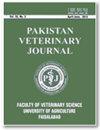Gross Morphological and Ontological Studies on Pituitary of Camel (Camelus dromedarius)
IF 5.4
3区 农林科学
Q1 VETERINARY SCIENCES
引用次数: 0
Abstract
Received: Revised: Accepted: Published online: March 24, 2018 May 17, 2019 October 22, 2019 November 11, 2019 Thirty normal male and female camels (Camelus dromedarius) with three age groups (2-4, 5-10 and 11-onward years) were selected for pituitary gross morphological and ontological studies. Body weight and pituitary were recorded; Mean body weight of camels and mean relative pituitary gland weight as a percent of body weight were calculated. In camels of age greater than 11 years, body weight significantly correlated with relative pituitary weight (r=-0.754*), overall correlation of female body weight and pituitary weight irrespective of their age was highly significant (r=0.888**). Whereas, the body weight of female camel between 5-10 years of age reflected a significant correlation with relative pituitary weight (r=0.882*). The cells of adenohypophysis were arranged in the cluster and formed the pars distalis and pars intermedia. Overall acidophil in the pituitary of camels were higher than chromophobes and basophils while basophils were the lowest in number as compared to other two types of cells. It is concluded that body weight of camel is suggestive of its correlation with pituitary weight, sex and age. ©2019 PVJ. All rights reserved骆驼垂体的大体形态学和本体学研究
接收:修订:接受:在线发布:2018年3月24日2019年5月17日2019年10月22日2019年11月11日选择30头三个年龄组(2-4岁、5-10岁和11岁以上)的正常雄性和雌性骆驼(骆驼)进行垂体毛形态和本体研究。记录体重和垂体;计算了骆驼的平均体重和垂体的平均相对重量(占体重的百分比)。在年龄大于11岁的骆驼中,体重与垂体相对重量显著相关(r=-0.754*),无论年龄大小,雌性体重与垂体重量的总体相关性都非常显著(r=0.888**),5~10岁雌性骆驼的体重与垂体相对重量呈显著相关(r=0.882*),腺垂体细胞呈簇状排列,形成远侧部和中间部。骆驼垂体中的总嗜酸性细胞高于嫌色细胞和嗜碱性细胞,而与其他两种类型的细胞相比,嗜碱性细胞的数量最低。结果表明,骆驼的体重与垂体重量、性别和年龄有关。©2019 PVJ。保留所有权利
本文章由计算机程序翻译,如有差异,请以英文原文为准。
求助全文
约1分钟内获得全文
求助全文
来源期刊

Pakistan Veterinary Journal
兽医-兽医学
CiteScore
4.20
自引率
13.00%
发文量
0
审稿时长
4-8 weeks
期刊介绍:
The Pakistan Veterinary Journal (Pak Vet J), a quarterly publication, is being published regularly since 1981 by the Faculty of Veterinary Science, University of Agriculture, Faisalabad, Pakistan. It publishes original research manuscripts and review articles on health and diseases of animals including its various aspects like pathology, microbiology, pharmacology, parasitology and its treatment. The “Pak Vet J” (www.pvj.com.pk) is included in Science Citation Index Expended and has got 1.217 impact factor in JCR 2017. Among Veterinary Science Journals of the world (136), “Pak Vet J” has been i) ranked at 75th position and ii) placed Q2 in Quartile in Category. The journal is read, abstracted and indexed internationally.
 求助内容:
求助内容: 应助结果提醒方式:
应助结果提醒方式:


